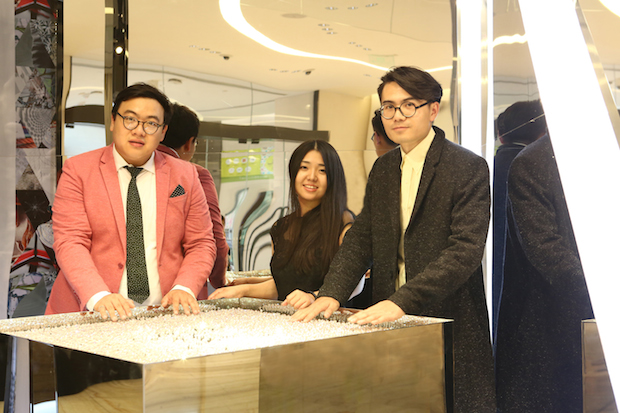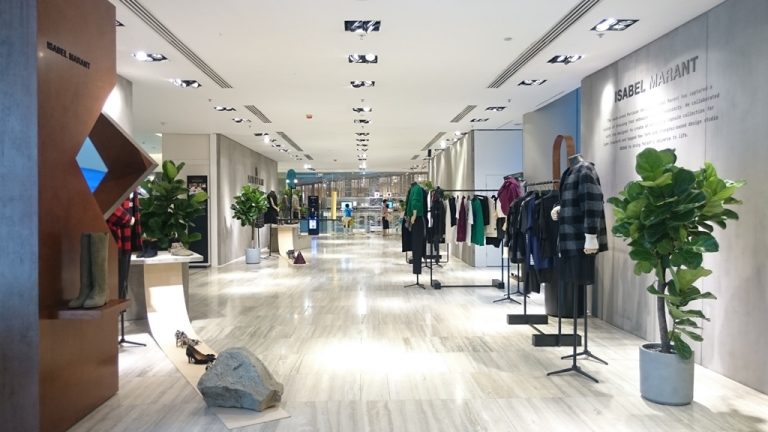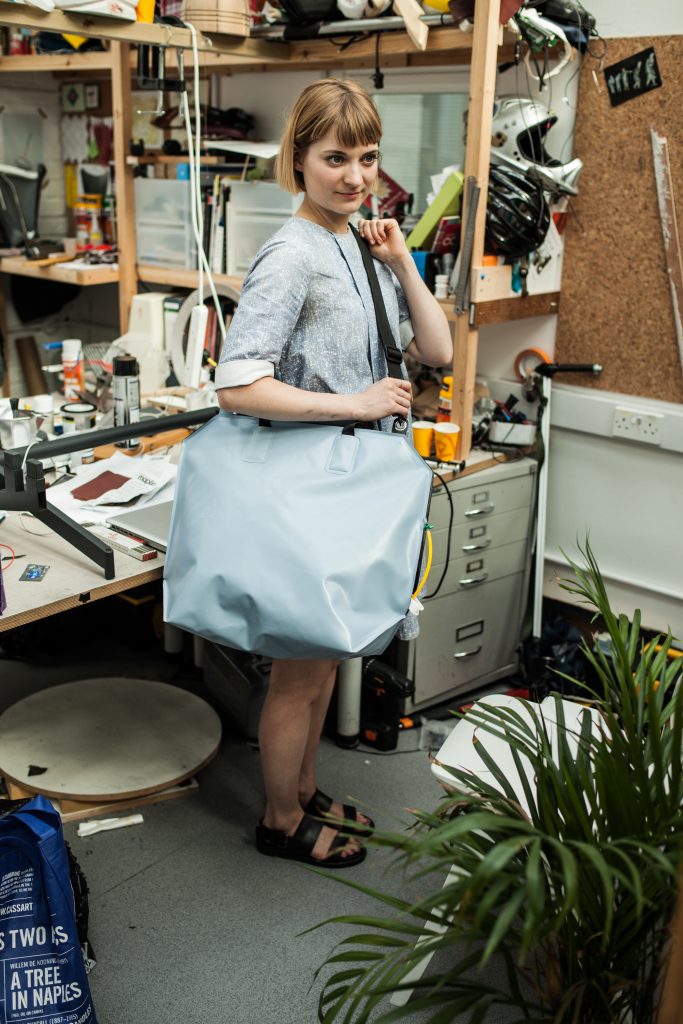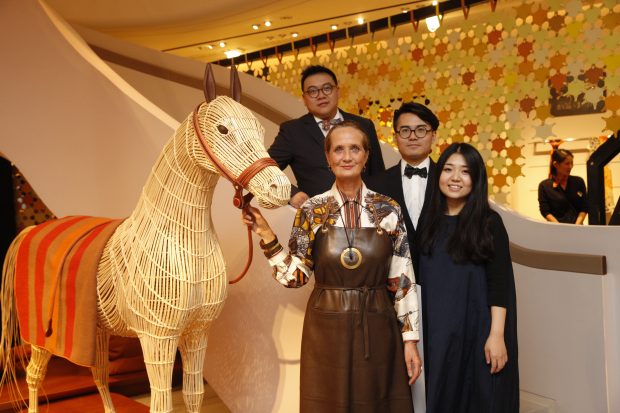Interview: Benwu Studio Gives Hermès and Vacheron Constantin a ‘Designed-in-China’ Edge
Quality, functional design is making its way into the day-to-day lives of China’s rich. And it’s no longer reserved for the ultra-wealthy, nor is it only sourced from the leading Scandinavian and Italian brands that are part of Beijing Design Week or Design Shanghai and opening flagships across the country.

Benwu Studio members Hongchao Wang (L), Wei Ge (C), and Peng You (R) with an installation at Lane Crawford.
Quality, functional design is making its way into the day-to-day lives of China’s rich. And it’s no longer reserved for the ultra-wealthy, nor is it only sourced from the leading Scandinavian and Italian brands that are part of Beijing Design Week or Design Shanghai and opening flagships across the country. China’s designers are growing in number, with Design Shanghai dedicating half of its roster to them earlier this year—a big change since 2014, when international designers dominated the event. Many craftsmen are relatively unknown on the commercial front, with only a few independent home furnishings boutiques establishing brick-and-mortar stores in first-tier cities, like Beijing-based Lost and Found and Hangzhou-bred Fnji. The past two years also saw at least one innovative new online store, Zaozuo, making Chinese-led, everyday design more accessible to China’s growing middle class consumers.
Then there are those who are somewhere in between commercial and experimental, and who are making strides in creating visual feasts for China’s high-end department stores and shopping malls. Benwu Studio is one of these design teams. Founded by friends Hongchao Wang and Peng You in 2011, the 26-year-old designers split their time between New York, Shanghai, and Beijing, dividing their schedule between creating products that are easy to use in the home and collaborating with luxury brands.

Benwu Studio’s installation for Isabel Marant at Lane Crawford in Hong Kong, China. (Courtesy Photo)
Hongchao Wang lived and worked in New York before finding the brand and completed a masters in design for luxury and craftsmanship in Switzerland. The two have introduced designers Wei Ge and Qiyun Deng to their team, who help create furniture, bags, home accessories, and more. Their roster of luxury collaborations include a project for Isabel Marant at Lane Crawford last August, Hermès, Vacheron Constantin, Cassina, Mini, Baccarat, Swarovski, Perrier-Jouët, and Rémy Martin.

Benwu Studio’s Fugu Bag, a sturdy, waterproof case for carrying electronic gadgets. (Courtesy Photo)
Jing Daily caught up with Wang shortly after he and his team accepted their award for “Best Design” for their beechwood “Sumo Chair” as part of AD China and Design Shanghai’s Emerging Chinese Designer Platform this year. We talked about how Chinese consumers approach buying furniture and also learned more about their other projects, such as how they helped Hermès relate to a Shanghai audience.
What does this award mean to you?
We feel thrilled that the jury chose us. It is definitely great motivation!
You came together in New York City, but later you moved to Shanghai and Beijing. What made you decide to make this move?
The Chinese market has been growing at an incredibly fast pace lately and, being Chinese myself, I felt it was the right move for me at that time. It helped me and my team gain more resources and grow bigger in a relatively short time. I truly believe that to keep practicing is the only way to approach design and create valuable products.
Tell us about a few of your highlight collaborations with luxury brands.
We have collaborated with a range of great luxury brands. Among them was Hermès, which commissioned us for the Petit h exhibition; the pop-up was set in Shanghai, on the ground floor of Hermès’ flagship store on Huaihai Road. Collaborating as a local artist was an extremely important milestone for Benwu Studio. It was such an honor to work closely with Pascale Mussard, director of the Petit h line at Hermès and have the opportunity to get to know the brand in Paris, translating Hermès’ values in a very Shanghainese way. The final result was an enormous leather “forest” with hidden tree houses crafted in charring wood and leather roof tiles.

The Benwu Studio team poses in Hermès in Shanghai in November 2015 with Pascale Mussard, creative director of the Petit h collection. (Courtesy Photo)
How do you think the Chinese consumer’s appreciation for design has changed in the last five years? What are wealthy consumers looking for now?
We have been doing business in China for only a year and a half , but I can feel that the Chinese audience is particularly hungry for novelty. Local costumers absolutely love what’s new and trendy.
What are your most popular products in your shop?
The office chair created by our partner Qiyun Deng called “Pegus” is one of the best sellers.
What cities do most of your customers come from?
They are mainly from Shanghai and some of them are from Beijing.
A lot of Chinese consumers are working with smaller living spaces—how do you incorporate this into your furniture and homeware design?
We chose to address compact living, not because it is a trend, but because it is a necessity. There has not been a strong offering on the market in China so far, so our solution grew organically out of our own experience. We wanted to address solutions [to smaller living spaces] that we were facing here in Shanghai, but they had also to be relevant in Beijing, Hong Kong, China, or even New York.

Benwu Studio’s 4×4 Vessels, whose parts can be rearranged to have 16 different functions. (Courtesy Photo)
Do Chinese consumers choose an investment design piece for their home in the same way they would buy art or nice jewelry?
Chinese consumers’ approach to these industries is quite different. In China, people are usually much more interested in investing in big pieces of jewelry or clothing rather than contemporary design-led furniture.
What are some design trends that you have picked up in your work? Do you take inspiration from global design trends or are you more focused on what’s going on in China?
We like trendy products, but there is no need to be a trend follower as there are so many exciting new products in China. However, we do study trends and we sometimes make strategic move to certain areas.
What are some projects you have in the works?
We have got so many new projects at the moment! I am afraid I can’t reveal too much, but we have a lot of new products in the pipeline, ranging from interior design to set design and many more.
(Source: jingdaily Author: Jessica Rapp)

 沪公网安备31010402003309号
沪公网安备31010402003309号



